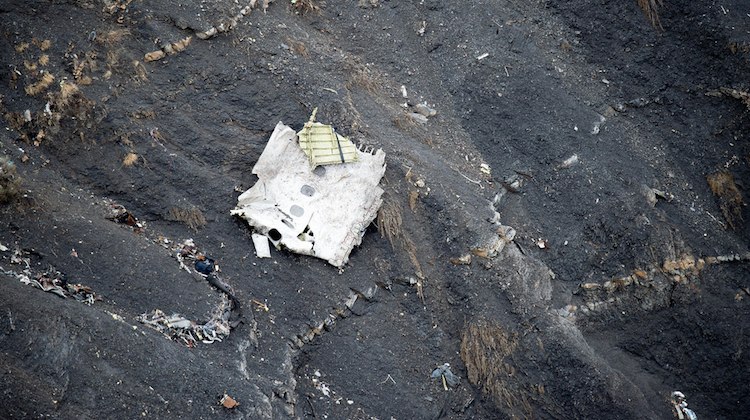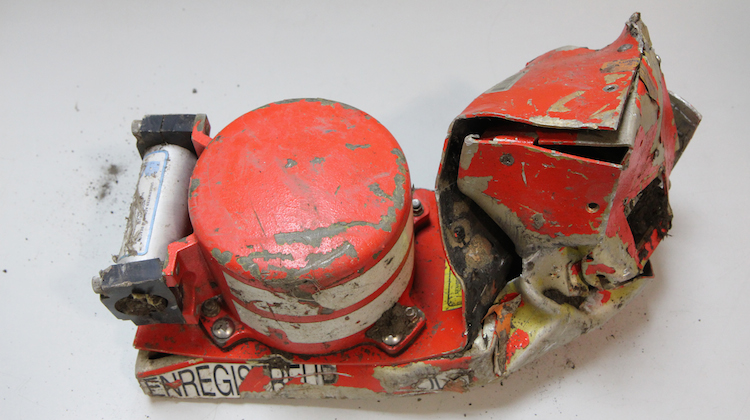
Confirmation that the co-pilot was alone in the cockpit of Germanwings flight 4U 9525 when it crashed into the French Alps killing all 150 people on board while the captain was locked out has prompted airlines around the world to change their operating procedures and regulators to review current rules.
Marseille prosecutor Brice Robin said information from the cockpit voice recorder indicated the copilot Andreas Lubitz, 28, intentionally started a descent and ignored attempts from air traffic controllers to contact the aircraft and prevented the captain from returning to his seat.
Investigators said knocking and pounding can be heard on the recording, indicating the captain, Patrick Sonderheimer, was attempting to regain entry to the cockpit.

Following the stunning revelations from France overnight, airlines around the world have moved quickly to update their operating procedures and reassure the travelling public by introducing a requirement that two people be present in the flightdeck at all times.
The BBC reported Canadian airlines Air Canada, Westjet and Air Transat, along with European carriers Norwegian Air Shuttle, Lufthansa, Air Berlin, Easyjet, Monarch Airlines, Virgin Atlantic and Thomas Cook were changing their operating procedures.
Meanwhile, the Germanwings incident has prompted Transport Canada to review “all policies and procedures that may be applicable to ensure the safety and security of the travelling public,” Transport Minister Lisa Raitt said.
“In light of reports this morning, I will be issuing an interim order which would require two crew members be in the flightdeck at all times to ensure the security of Canadian passengers,” Raitt said a statement.
“We are following the situation in Europe very closely.”
The New Zealand Civil Aviation Authority (CAA) has also moved to introduce rules requiring there be two people in the cockpit at any time.
“Effective today the CAA requires large jet aircraft operators in New Zealand to ensure they have a minimum of two people in the flightdeck at any given time,” NZ acting director of civil aviation John Kay said in a statement.
“This applies to domestic and international flights. This new stipulation recognises that temporary inflight incapacitation could occur for a number of reasons, including a medical event.”
“The CAA takes a precautionary approach on such matters in the interests of safety.”
In Australia, oversight of the aviation sector is split between the Civil Aviation Safety Authority (CASA), which as its name suggests deals with safety matters including checks of pilots mental health, while the Department of Infrastructure and Regional Development’s Office of Aviation Security handles security issues.
Deputy Prime Minister and Minister for Infrastructure and Regional Development Warren Truss said the government and its aviation security and safety agencies would investigate if current cockpit security and safety requirements needed further strengthening.
Truss said Australia had strict safety regulations to safeguard passengers, with a “preventative, layered approach to aviation security”.
The Minister confirmed current regulations in Australia did not require airlines to replace a pilot who temporarily left the cockpit.
Those rules were not being changed at this time.
“Careful consideration needs to be made following thorough investigation to ensure that altering current procedures does not open other potential vulnerabilities,” Truss said in a statement on Friday.
“Our two major international and domestic airlines are undertaking their own safety and security risk assessments of cockpit procedures following the recent tragedy.”
Airlines around the world reinforced cockpit doors and introduced stricter rules for entry after the September 11 2001 terrorist attacks in the United States. Entry to the cockpit is usually by a code being entered on a touchpad. However, someone in the cockpit can “lock” the door to prevent it being opened even if the correct code is entered on the touchpad.
While US airlines require two people be in the flightdeck at all times – for example if a pilot has to use the lavatory a cabin crew member enters the flightdeck – not all jurisdictions or airlines, including Germanwings, have this rule.
The UK Civil Aviation Authority (CAA) said it was monitoring the situation as the investigation into the Germanwings incident developed.
“Following the details that have emerged regarding the tragic Germanwings incident, we are co-ordinating closely with colleagues at the European Aviation Safety Agency (EASA) and have contacted all UK operators to require them to review all relevant procedures,” the CAA said in a statement.
Reports from Europe also indicated Lubitz had suffered a “personal life crisis” and had been treated for depression in the past, raising the issue of the pilot’s mental state on the day he operated 4U9525.
CASA did conduct psychological checks on those applying for a pilot’s licence, as well as in follow up tests with designated aviation medical examiners (DAMEs). Airlines also conduct psychometric and psychological tests when pilots apply for a job and during their period of employment.
Qantas said in a statement doctors conducted aeromedical tests once a year for its pilots under 40 and every six months for those over 40.
Pilots were also required to complete regular training that stress management, teamwork, communication and behavioural awareness, the airline said.
“We have a comprehensive safety management system that guards against risks to our operations. This includes multi-layered systems to protect the flightdeck on our aircraft,” a Qantas spokesperson said in an emailed statement on Friday.
“We are monitoring the information coming out of the French investigation and considering if any changes to our existing safeguards are needed. This includes discussions with regulators.”
Virgin Australia has been contacted for comment.
The NZ CAA noted all NZ airline pilots had to undergo extensive and recurrent medical assessments to determine their fitness to hold a licence.
“These detailed medical assessments are in-line with international aviation standards,” the NZ CAA’s Kay said.
The Virgin Independent Pilots Association (VIPA) said it supported an international review of cockpit safety procedures.
“VIPA and the wider pilot community have been concerned about a pilot’s ability to access the cockpit under all circumstances,” VIPA president Captain John Lyons said in a statement.
“We won’t be offering any further comment at this stage, given the matter is under investigation by authorities.”
VIPA also said it had “full confidence in Virgin Australia’s recruitment policies and its ongoing full-performance monitoring which our pilots undertake at least twice a year”.
“We can attest to the fact that Australian pilots operate to the highest standards of world aviation practice on a daily basis,” he said.
“VIPA also offers a peer support program to assist and counsel pilots for any work or private stress-related issues they may experience.”
















GAGA
says:A knee jerk reaction.
This NZ decision that “recognises that temporary inflight incapacitation could occur” doesn’t make any sense. So a suicidal pilot incapacitates the other pilot and locks them together in the cockpit.
Is the A320 considered “Large jet aircraft” and is there enough room for a third pilot to enter a A320 cockpit and swap seats with one of the pilots? The thought of a A320 Captain trying to vacate his seat whilst a third pilot is in the cockpit and trying to get in that seat is laughable.
Ben
says:Entry to the flight deck is NOT normally by entering the code. Normally it would be by contacting the flight deck and requesting entry on an interphone (ie what the flight attendants use). Use of the emergency access code is only for use when the flight deck is not responding to normal access requests by the interphone. Yes, the use of the emergency code can be over-ridden, the intent was to prevent someone who had a crew member enter it under duress from entry.
Adrian
says:It could be argued that the reinforced cabin door was a knee jerk reaction to 9-11, and the resolution to this issue will require more than one solution. It is not the first time an employee has done this, which is why the USA requires a minimum of 2 employees to remain in the cockpit.
When you consider some crews only fly with each other 3 or 4 times a year it must be quite lonely and difficult to form friendships to resolve personal issues. Perhaps rostering from smaller flight crew pools might help in team work and spotting trends in behaviour?
Trev
says:Allowing cabin crew into airline cockpits introduces a high risk factor because in addition to ensuring pilots are ok it would be necessary to guarantee ALL cabin crew are ok at ALL times, a hopeless task cdrtain to fail. Better to make independent access to pilot medical records mandatory.
BANKS
says:I think this scenario is so rare that airlines/regulators need to take a practical approach rather than the typical knee jerk…
In the event that flight crew can’t access the cockpit by entering the traditional code which can be overridden in the cockpit, the flight crew can enter half a code and the cabin supervisor entering the other half. This code can not be overridden by the cockpit and ensures that crew can not be locked out, while remaining security that one person can not solely gain access wirhout someone else knowing.
Greg Stevenson
says:I have just read that the Australian Government are going to regulate that there has to be TWO PILOTS on the flight deck at all times, of all Australian internal and international flights.
This is in response to the Germanwings incident.
That is very well but I have some questions.
What if one of the TWO flight deck crew want to go to the toilet?
Has he got to hold on until he lands or are the airlines going to allocate another flight deck crew member to all flights?
Are we going back to the old days were there was three flight deck members; a captain, a Second Officer and a Flight Engineer. The Flight Engineers position was taken over by computers.
Maybe; worldwide there should be more thought put into a solution.
Scott
says:A knee jerk reaction to an earlier knee jerk reaction thats now been used by this pilot to murder 149 people.
Reinforced cockpit doors were introduced as an over reaction, post 9/11 in a poorly thought out knee-jerk. In the same pathetic way of forcing non-jet flying PPL pilots to undergo an ASIC card revalidation every two yeas at great cost despite no link whatsoever that an ASIC would have helped or prevented 9/11 from the box-cutter armed terrorist.
In forcing AIrlines to retrofit armoured doors, at great cost, some aircraft were not able or viable to be modified and were retired early, causing great cost and waste all in the name of safety, apparently. In typical do it or else fashion. As an unintended consequence now, pilots can be trapped inside the cockpit unable to be rescued quickly in the event of a crash, so a device mandated to save lives, is killing more lives. Clever..!
If a cockpit door can be opened in flight, there will be potential loop-holes for a Terrorist to use, heaven forbid a non-ASIC wearing terrorist ever does that.
Its time that the “experts” took some advice from industry and removed the unneccesary burdens from law-abiding pilots and crew so that the real emphasis can be directed at those who deserve it. I have friends with Government Top Secret security clearances that still have to pay for an ASIC card despite being more highly vetted by the same Government which refuses to talk to eachother.. Where is the safety or efficiency in that..? Clearly there is none. You Only make things safer by having all hands talking to eachother, not pretty cards strung around a law abiding pilots neck..!
Nigel
says:Lubitz was hell bent on carrying out this atrocity, do you think one flight attendant in the flight deck would have stopped him? This is about making the travelling public feel safe.
Another knee jerk reaction to a knee jerk reaction!